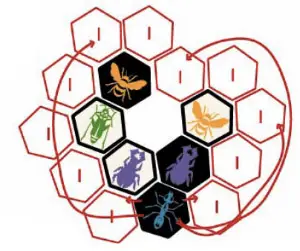This is something I have been working on and I just finished implementing the game “engine” (for lack of a better term) while I do not have an actual game yet.
The actual rules are only tentative and incomplete at this time but I will mention what I have in the hope that other people might chime in with suggestions:
The general mechanic is that it would be a 2 player game (at least at first) with a fixed number of pieces. As there is no “board” per-se for Blink games (well, Hexxagon technically makes a board out of the Blinks themselves) the “pieces in fixed starting positions” from chess is replaced by “pieces join the game one by one” at each player’s turn.
Each Blink would have a role (like in Crownfall) with multiple Blinks in the same role being possible. Each role would, as expected, have different properties (more on this below).
Either during the setup phase (where pieces are being added one by one) or after it finishes (all pieces are in), players would be able to start moving pieces around.
As In chess, each piece can move only in a specific way (to be determined) but probably related to how they can be moved from one place in the cluster of Blinks to another place in the same cluster.
Also as in chess, the main objective would be to capture a specific piece (a king?). How that would happen is still up for discussion but an obvious way would be if it was surrounded by pieces for the other player (depending on how this would play out with other movement rules, of course).
Some generic rules common to several Blink games would apply here: There can be only one cluster (so moving a piece can not break it in 2). Pieces can only be moved if they can easily be removed and inserted in another position (this probably excludes moving pieces in the middle of the cluster although I THINK this could be relaxed depending on how pieces move), pieces must be touching at least one other piece to be in game (with some specific logic to sort up the first move where there would be a single piece, maybe just having an initial cluster with one piece from each player).
And, in case it is not clear yet, a move means physically moving pieces around the cluster following the specific movement rules.
The cool thing about what I intend to do (and I am not sure I can do everything I want due to space constraints) is that it will feel and play like a normal table top game with discrete pieces (think, dominoes) but other than animations I intend to add game hints (for example, when a piece is removed, the cluster will indicate where that same piece that was removed can be reconnected to it), cluster validation (for detecting invalid states and end game condition) which is something that can only be done with Blinks.
This is how far I went with this so far. Any suggestions about ANYTHING (specially game mechanics/rules) would be greatly appreciated.
 ), it seems to be exactly the type of game I had in mind (and I thought I had an original idea…).
), it seems to be exactly the type of game I had in mind (and I thought I had an original idea…).
 I will eventually get back to it at some point.
I will eventually get back to it at some point.

